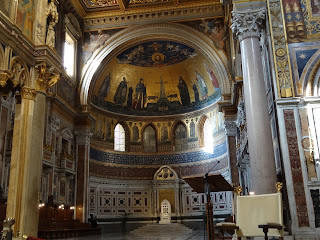Today is Earth Day, set aside
since 1970 to recall our connectedness to the earth and to call us to respond
to the threats to the integrity of creation.
St. Francis of Assisi has often
been invoked as a patron of ecology because of his love of all creation. He
preached to birds and fish; he rescued worms from pathways; he established a
truce between a wolf and the people of Gubbio.
Julien Green, in God’s Fool: the Life and Times of Francis of Assisi, wrote of
Francis’ mystical stance before the created world:
Francis glanced around him like a lover who is forever wonderstruck.
 |
| Francis dictating the Canticle of the Creatures |
But there is another element
of Francis’ spirituality that would help us to foster an ecological spirituality:
his kinship with all creation. This can be seen most clearly in his Canticle of
the Creatures, he praises God through all creatures.
Francis has definitely moved
beyond the dominion theology that sees the human person as the lord of
creation, over it, with power to do what he wants. This theological approach
dominated Christian thought for centuries and still is strong among those who
see humans as above nature with unlimited power to do what humans want.
Francis also has moved beyond
a more recent stewardship theology that sees the human person as the steward of
creation which he has to care for, in responds to God’s command. Stewards see
themselves in charge of nature, even if it doesn’t belong to them. In this
model we humans are not dominating nature but we are the caregivers in charge
of the garden of creation.
But Francis sees himself and
all humans as within creation. We are part of nature, with our special part in
it, as all beings also have a part in the created universe.
And so Francis praises God
for Brother Sun, Sister Moon, Sister Mother Earth. We are interconnected, part
of the web of life, of creation.
And so Francis sought to
establish good relations with all animals and between animals and humans. The
story of the wolf of Gubbio shows Francis seeking to establish a relationship
of trust and reconciliation between the wolf and the people of Gubbio.
When we see ourselves as part
of creation and nature, we can respect all creatures and recognize their part
in the wonderful work God has made.
This will need humility,
recognizing that we too are made of humus,
earth. As the last line of Francis’ Canticle says:
Praise and bless my Lord, and give thanks, and serve him with great humility.
And so this earth day, let us
remember that we are part of the beautiful creation that God has made. Let us
rejoice in our God who has made us all to rejoice in His love, to wait with all
creation, eagerly longing “for the revealing of the children of God.” (Romans
8:19).
And let us love God and love
and cherish all that God has made as our brothers and sisters.
---
This entry was inspired by
the essay “From Stewardship to Kinship: A Franciscan Understanding of Creation”
by Fr. Dan Horan, OFM, in his anthology of essays Francis of Assisi and the Future of Faith.
The image in the photo is on the wall of the friary attached to the church of San Damiano, which can be seen as one walks down from the town of Assisi to the church.





